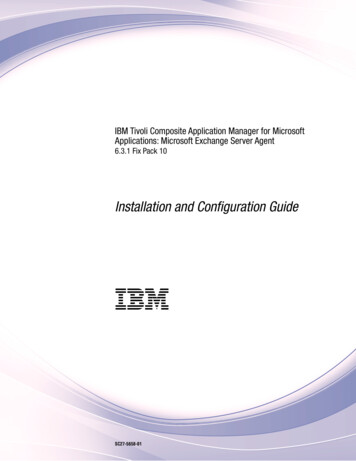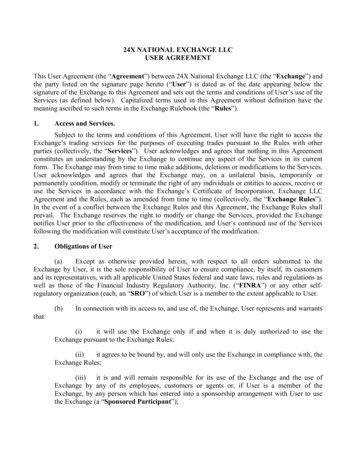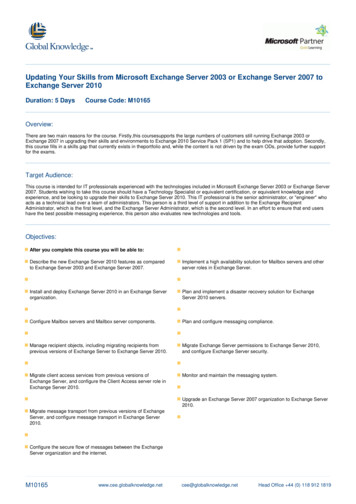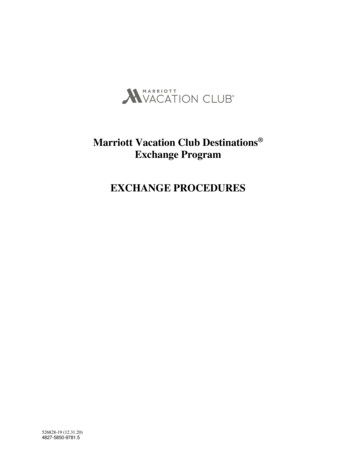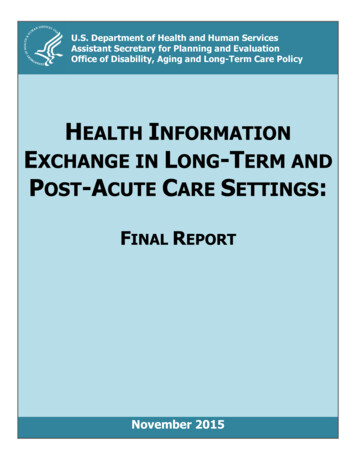
Transcription
U.S. Department of Health and Human ServicesAssistant Secretary for Planning and EvaluationOffice of Disability, Aging and Long-Term Care PolicyHEALTH INFORMATIONEXCHANGE IN LONG-TERM ANDPOST-ACUTE CARE SETTINGS:FINAL REPORTNovember 2015
Office of the Assistant Secretary for Planning and EvaluationThe Office of the Assistant Secretary for Planning and Evaluation (ASPE) is theprincipal advisor to the Secretary of the Department of Health and Human Services(HHS) on policy development issues, and is responsible for major activities in the areasof legislative and budget development, strategic planning, policy research andevaluation, and economic analysis.ASPE develops or reviews issues from the viewpoint of the Secretary, providing aperspective that is broader in scope than the specific focus of the various operatingagencies. ASPE also works closely with the HHS operating agencies. It assists theseagencies in developing policies, and planning policy research, evaluation and datacollection within broad HHS and administration initiatives. ASPE often serves acoordinating role for crosscutting policy and administrative activities.ASPE plans and conducts evaluations and research--both in-house and through supportof projects by external researchers--of current and proposed programs and topics ofparticular interest to the Secretary, the Administration and the Congress.Office of Disability, Aging and Long-Term Care PolicyThe Office of Disability, Aging and Long-Term Care Policy (DALTCP), within ASPE, isresponsible for the development, coordination, analysis, research and evaluation ofHHS policies and programs which support the independence, health and long-term careof persons with disabilities--children, working aging adults, and older persons. DALTCPis also responsible for policy coordination and research to promote the economic andsocial well-being of the elderly.In particular, DALTCP addresses policies concerning: nursing home and communitybased services, informal caregiving, the integration of acute and long-term care,Medicare post-acute services and home care, managed care for people with disabilities,long-term rehabilitation services, children’s disability, and linkages between employmentand health policies. These activities are carried out through policy planning, policy andprogram analysis, regulatory reviews, formulation of legislative proposals, policyresearch, evaluation and data planning.This report was prepared under contract #HHSP23320100025WI between HHS’sASPE/DALTCP and the Urban Institute. For additional information about this subject,you can visit the DALTCP home page at ng-term-care-policy-daltcp or contact the ASPE Project Officers, Iara Woody andJennie Harvell, at HHS/ASPE/DALTCP, Room 424E, H.H. Humphrey Building, 200Independence Avenue, S.W., Washington, D.C. 20201; Iara.Woody@hhs.gov,Jennie.Harvell @hhs.gov.
HEALTH INFORMATION EXCHANGE IN LONG-TERMAND POST-ACUTE CARE SETTINGS:Final ReportKelly DeversNicole LallemandAmanda NapolesBrenda SpillmanFred BlavinUrban InstituteGary OzanichHealthTech SolutionsNovember 2015Prepared forOffice of Disability, Aging and Long-Term Care PolicyOffice of the Assistant Secretary for Planning and EvaluationU.S. Department of Health and Human ServicesContract #HHSP23320100025WIThe opinions and views expressed in this report are those of the authors. They do not necessarily reflectthe views of the Department of Health and Human Services, the contractor or any other fundingorganization.
TABLE OF CONTENTSACRONYMS . iiiEXECUTIVE SUMMARY . viPURPOSE AND BACKGROUND . 1Long-Term and Post-Acute Care Providers . 1Purpose of this Study . 3Conceptual Framework . 5Methods . 10FINDINGS: PREPARING FOR eHIE BETWEEN LTPAC PROVIDERS ANDEXCHANGE PARTNERS . 16Funding and Financing . 16Health Information Technology for Economic and Clinical Health Programs . 22Privacy and Security Laws and Regulations . 23The Improving Medicare Post-Acute Care Transformation Act of 2014 . 25Medicare and Medicaid Programs: Reform of Regulations for Long-Term CareFacilities; Proposed Rule . 25Payment and Delivery Reforms . 26Long-Term and Post-Acute Care Provider Preparation Activities. 34FINDINGS: IMPLEMENTING eHIE BETWEEN LTPAC PROVIDERS ANDEXCHANGE PARTNERS . 37Types of Information Required to Support Continuity of Care . 37Electronic Health Record Penetration in Long-Term and Post-Acute CareFacilities . 38Health Home versus Long-Term Care . 39Methods of Exchange. 40Innovative Solutions . 42FINDINGS: ASSESSING THE IMPACT OF eHIE BETWEEN LTPACPROVIDERS AND THEIR EXCHANGE PARTNERS . 44Workflow . 44Impact and Evaluation . 50CONCLUSION: ISSUES TO CONSIDER . 60APPENDICESAPPENDIX A.APPENDIX B.APPENDIX C.Literature Review Bibliography . A-1Technology . A-9Quantitative Evaluation Plan . A-11i
LIST OF FIGURES AND TABLESFIGURE 1. Conceptual Framework for Studying EHIE Involving Nursing Homeand Home Health Providers . 5TABLE 1.Exchange Alternatives for LTPAC Providers . 40TABLE 2.Cross-Setting Comparisons . 59TABLE C-1. Cross-Setting Comparisons . A-27ii
ACRONYMSThe following acronyms are mentioned in this report and/or ordable Care ActAccountable Care CollaborativeAccountable Care OrganizationAccelerating Change and Transformation in Organizations andNetworksAdmission Discharge TransferAssisted Living FacilityAll-Payer Claims DatabaseApplication Program InterfaceAmerican Recovery and Reinvestment ActHHS Office of the Assistant Secretary for Planning HIOCRISPConsolidated-Clinical Data ArchitectureCertification and Survey Provider Enhanced ReportsContinuity of Care DocumentChronic Conditions WarehouseCertified Electronic Health Record TechnologyCenter for Improving Value in Health CareCenter for Medicare and Medicaid InnovationHHS Centers for Medicare and Medicaid ServicesColorado Regional Health Information OrganizationChesapeake Regional Information System for our PatientsDSMDirect Secure Messaginge-INTERACTeHIEEHREMSERInterventions to Reduce Acute Care TransfersElectronic Health Information ExchangeElectronic Health RecordEmergency Medical ServicesEmergency RoomFFSFHIRFOAFee-For-ServiceFast Healthcare Interoperability ResourceFunding Opportunity AnnouncementHCBSHEAL NYHome and Community-Based ServicesHealthcare Efficiency and Affordability Law for New YorkersCapital Grant Programiii
ome Health AgencyU.S. Department of Health and Human ServicesHealth Information ExchangeHealth Information and Management Systems SocietyHealth Information OrganizationHealth Insurance Portability and Accountability ActHealthcare Information Services ProviderHealth Information TechnologyHealth Information Technology for Economic and Clinical HealthHealth Information Technology for Post-Acute CareHealth Level SevenHHS Health Resources and Services ional Classification of Diseases, ninth versionIntegrated Delivery NetworkIntegrated Delivery System or NetworkIndiana Health Information ExchangeImproving Medicare Post-Acute Care TransformationInstitutional Review BoardInpatient Rehabilitation FacilityKeyHIEKeystone Health Information ExchangeLANDLTCHLTPACLocal Adopter for Network DistributionLong-Term Care HospitalLong-Term and Post-Acute CareMAXMDHMDSMeHIMiHINMSISMUMedicaid Analytic ExtractMinnesota Department of HealthMinimum Data SetMassachusetts eHealth InstituteMichigan Health Information NetworkMedicaid Statistical Information SystemMeaningful UseNFNHNursing FacilityNursing HomeOHIPONCOhio Health Information PartnershipHHS Office of the National Coordinator for Health atient-Centered Medical HomePortable Document FormatPerformance-Based Incentive Payment Planiv
QIOQuality Improvement OrganizationRCCORECRFPRHIOROIRegional Care Collaborative OrganizationRegional Extension CenterRequest for ProposalRegional Health Information OrganizationReturn on InvestmentSEESHADACSIMSNFSurrogate Electronic Health Record EnvironmentState Health Access Data Assistance CenterState Innovation ModelSkilled Nursing FacilityT-MSISTEFTTransformed Medicaid Statistical Information SystemTesting Experience and Functional Toolsv
EXECUTIVE SUMMARYIn this report, we describe findings related to electronic health informationexchange (eHIE) involving long-term and post-acute care (LTPAC) providers. Thesequestions cover three general areas: preparing for eHIE between LTPAC providers andtheir exchange partners, implementing eHIE between LTPAC providers and theirexchange partners, and assessing the impact of those activities.We addressed these questions through several methods, including: A review of grey and published literature from the past three years. Discussions with 22 stakeholders representing 12 regions where eHIE initiativesinvolving LTPAC providers are completed or ongoing. In-depth case studies of three eHIE initiatives in which LTPAC providersparticipate (one project in the Northcentral and Northeast regions ofPennsylvania and two projects in and around Minneapolis, Minnesota).Awareness is growing that LTPAC providers play a critical role in care coordinationand related payment and delivery system reforms intended to improve quality andreduce costs. These include accountable care organizations (ACOs), hospital and postacute care bundling, various integrated care delivery models, and Medicare’s hospitalreadmission policy.1 eHIE between LTPAC providers and other providers is a promisingand important strategy for achieving the goals of improving care coordination andquality, and reducing the cost of care.Yet, despite the increased focus on the importance of LTPAC providers in the carecontinuum, results from this project indicate that integration into electronic dataexchange is still in its infancy even among providers who were eligible to participate inthe electronic health record (EHR) Incentive Programs. A recent GovernmentAccountability Office report, for example, described 18 selected eHIE initiatives as beingin their infancy.2 Moreover, integration of LTPAC providers into eHIE activities is1Devers, K., N. Lallemand, G. Ozanich, et al. 2015. Health information exchange in long-term and post-acute caresettings: Conceptual framework. Commissioned by the Assistant Secretary for Planning and Evaluation. Freedman,V., and B. Spillman. 2014. Disability and care needs among older americans. Milbank Quarterly, 92(3): 509-41,doi:10.1111/1468-0009.12076. Stefanacci, R.G., and B.S. Spivack. 2014. Long-term care regulatory and practicechanges: Impact on care, quality, and access. Annals of Long-Term Care, pact-care-qualityand-access.2Government Accountability Office. 2015. Nonfederal efforts to help achieve health information interoperability.GAO-15-817, http://www.gao.gov/assets/680/672585.pdf.vi
generally not the robust, bidirectional exchange typically envisioned in earlier studiesregarding the potential for improvements in care delivery and outcomes.3LTPAC providers were sometimes involved in discussions and planning for eHIE inthe region, However, LTPAC providers typically were not prioritized for early eHIEefforts by providers eligible for meeting meaningful use (MU), which required eHIE tomeet Stage 1 and Stage 2 MU criteria for the Medicare/Medicaid EHR IncentivePrograms. Additionally, since LTPAC providers were not eligible for Medicare andMedicaid EHR incentives, they often did not have certified EHR technology, necessarymodules to support eHIE, or other technology solutions that would be needed to supportexchange. Finally, some LTPAC providers and their trading partners were not yetconvinced of the business case for exchange and/or wanted additional support(financial and technical) to implement EHRs, redesign workflows, and educate and trainstaff. While the fax and telephone have major limitations, moving to certified EHRs andeHIE is a significant challenge for LTPAC providers, their exchange partners, and anyintermediary (e.g., Health Information Organization or vendor).Despite these challenges, our stakeholder interviews and review of the grayliterature identified 12 regions around the country where LTPAC providers are involvedin the planning or implementation of eHIE and have started to engage in eHIE with keyexchange partners. We conducted stakeholder discussions with stakeholders at thefollowing organizations: Office of e-Health Initiatives (Tennessee);New York State Department of Health (New York);Keystone HIE (KeyHIE) (Pennsylvania);Massachusetts eHealth Institute (MeHI) (Massachusetts);Colorado Regional Health Information Organization (CORHIO) (Colorado);HealthInfoNet (Maine);Missouri Health Connection (Missouri);Michigan Health Information Network (MiHIN) (Michigan);Stratis Health (Minnesota);Ohio Health Information Partnership (OHIP) (Ohio); andChesapeake Regional Information System for our Patients (CRISP)(Maryland).The implementation of eHIE solutions between LTPAC providers and theirexchange partners has been shaped by several factors including: the exclusion ofLTPAC providers from MU Medicare/Medicaid EHR Incentive Program eligibility, aninstalled-base of technologies for the electronic reporting of administrative data3Devers, K., N. Lallemand, G. Ozanich, et al. 2015. Health information exchange in long-term and post-acute caresettings: Conceptual framework. Commissioned by the Assistant Secretary for Planning and Evaluation. Lallemand,N., A. Napoles, K. Devers, et al. 2015. Pennsylvania site visiting findings. Memorandum commissioned by theAssistant Secretary for Planning and Evaluation. Lallemand, N. , A. Napoles, K. Devers, et al. 2015. Minnesota sitevisit findings. Memorandum commissioned by the Assistant Secretary for Planning and Evaluation.vii
(minimum data set, Outcome and Assessment Information Set), regional variation in thetechnical approaches to eHIE, the degree of hospital system competition and verticalintegration within a region, financial resources for eHIE, and the strategies of nationaland regional LTPAC chains with facilities within a region.In places where early progress has been made, the implementation experiencehas been slow and mixed. The challenges of creating an affordable, feasible and usabletechnological solutions is difficult--more difficult than many anticipated. As we describefurther in this report, the technological solutions pursued have leveraged EHRtechnology that key exchange partners eligible for MU Medicare/Medicaid EHRIncentive Programs have developed, such as view-only portals, or eHIE effortsdeveloped for other providers and now adding on LTPAC providers. Otherimplementation challenges have been changing technology, leadership turnover at keyorganizations, workflow redesign, provider concerns and misconceptions about federaland state privacy and security laws, and education and training. Other implementationchallenges noted include competitive pressures and demands, lack of trust amongsome trading partners, and in some case legal concerns.Lack of funding and the business case for LTPAC providers to participate in robustinformation exchange has led to use of opportunistic and often very local solutions.Even in markets where relatively robust exchange is occurring for acute care providers,including hospitals, laboratories, and outpatient care in clinics and physician offices,LTPAC providers most often are limited to view-only access to clinical documents andpartial solutions that may be helpful short-term solutions (e.g., provider and hospitalportals) but reduce incentives for adopting more robust, interoperable EHR systems.However, a wave of new federal demonstrations and funding opportunities (e.g.,ACOs, health information exchange (HIO) grants from the U.S. Department of Healthand Human Services, Office of the National Coordinator for Health InformationTechnology and requirements and incentives is influencing eHIE initiatives and thestates and providers that choose to participate in those initiatives, and could potentiallyencourage more widespread use of eHIE among LTPAC providers. For example, thepresence of ACOs in many local markets across the United States is prompting someACOs and key participants in portions of them (e.g., hospitals) to reach out to LTPACproviders and conversely LTPAC providers in those communities to develop eHIEcapacity as a way to ensure that referrals from local hospitals continue in the future. TheImproving Medicare Post-Acute Care Transformation Act also has the potential toaccelerate LTPAC provider involvement in HIE through its provisions intended toencourage interoperable HIE with and by requirements for LTPAC providers reporting.A potential wildcard in predicting LTPAC involvement in eHIE initiatives goingforward is the technology used to engage in eHIE. Findings from the literature review,stakeholder discussions, and case studies suggest that those interested in advancingLTPAC involvement in eHIE initiatives should not wait for a so-called “silver bullet” thatwill produce seamless exchange between LTPAC providers and their exchangepartners. Instead, findings suggest that the likely near-term migratory path goingviii
forward will involve Direct Secure Messaging, view-only portals through hospitals andHIEs, and, due to considerable regional variation, smaller implementation efforts andassessment of their impacts (i.e., test of specific use cases). Other new innovativepathways, such as Transform, surrogate exchange environment, application programinterface, and EHR, offer promising but more mid-term and long-term solutions.Overall, progress is being made in involving LTPAC providers in efforts to engagein eHIE across the United States. New technology solutions offer better opportunities formore robust eHIE involving a wider swath of LTPAC providers. And new policy andmarket dynamics are convincing LTPAC providers, hospitals, medical groups, and otherproviders of the value to including LTPAC providers in eHIE efforts and are facilitatingmore robust eHIE more generally. Relatively little research is available on the impact ofthese eHIE exchange efforts because of the early stages of eHIE between LTPACproviders and their exchange partners, and there also are number of methodologicalchallenges to these studies. However, the time is ripe for targeted research andevaluations to continue learning about what works and what does not work in eHIEinitiatives involving LTPAC providers. The Urban Institute team describes promisingapproaches to conducting a targeted quantitative impact evaluation using ACOs orintegrated delivery systems or networks. The results of such an evaluation as well asother evaluations already underway will help to identify and spread promisingapproaches to eHIE involving LTPAC providers across the country.ix
PURPOSE AND BACKGROUNDThere is growing awareness that long-term and post-acute care (LTPAC) providersplay a critical role in care coordination and related payment and delivery reformsintended to improve quality and reduce costs, such as accountable care organizations(ACOs), hospital and post-acute care bundling, and Medicare’s hospital readmissionpolicy. Additionally, timely electronic health information exchange (eHIE) betweenLTPAC providers and other providers is a promising and critical strategy for achievingthese care coordination, quality improvement, and cost reduction goals.Long-Term and Post-Acute Care ProvidersLTPAC providers include a wide range of providers, such as: long-term carehospitals (LTCHs), inpatient rehabilitation facilities (IRFs), skilled and unskilled nursingfacilities (NFs),4 and home health agencies (HHAs). Other providers that deliver relatedhome and community-based services (HCBS) include hospice, assisted living facilities(ALFs), and adult day care. LTPAC and HCBS providers vary by relative emphasis on:(1) medical versus social service needs; and (2) restorative and recuperative servicesversus services intended to maintain functioning or slow deterioration (or in the case ofhospice service the delivery of palliative care).This project focuses on skilled and unskilled nursing facilities and HHAs to theextent possible. In addition to the request for proposal (RFP) requesting such a focus,NFs and HHAs are a major component of the LTPAC provider segment, with a relativelylarge number of facilities, beds, and residents/patients that are transitioning to and fromother health care providers, such as hospitals. Below we provide additional informationabout LTPAC providers, their adoption of electronic health records (EHRs), and aconceptual framework for understanding eHIE involving LTPAC providers.According to data from the American Health Care Association, there are 15, 632certified NFs and 1,368,351 patients in certified beds in the United States.5 In 2012,approximately 3% of the over 65 years of age United States population resided innursing homes (NHs), and approximately 11% of the 80 years of age United Statespopulation resides in NHs.6 Further, these segments of the United States populationare growing and so NF use as well as use of alternative care settings will rise.74Includes both NHs and skilled nursing facilities (SNFs).American Health Care Association. 2015. Trends in nursing facility characteristics.http://www.ahcancal.org/research data/trends statistics/Documents/Trend PVNF FINALRPT March2015.pdf.6Administration on Aging, Administration for Community Living. 2012. A profile of Older Americans: 2012. U.S.Department of Health and Human Services. http://www.aoa.gov/Aging y, PA. n.d. Advancing the health of our aging population: A lead role for nursing science. Nursing Outlook,59(4): 207-209, Science Citation Index, EBSCOhost.51
Home health care is another LTPAC setting that offers a possible alternative to NFcare and is a segment of the LTPAC provider market that is also growing rapidly.8 U.S.Department of Health and Human Services (HHS) Centers for Medicare and MedicaidServices (CMS) data indicates that as of 2010 there were 12,311 HHAs, and 3.4 millionbeneficiaries receiving home health services in the United States.9A recent issue brief by CMS, titled Medicare Post-Acute Care Episodes andPayment Bundling,10 also provides some critical information about the volume andnature of transitions of care between hospitals and LTPAC providers. Specifically, thereport notes that: Nearly 40% of patients discharged from the hospital received post-acute care. 14.8% of those patients are readmitted to an acute hospital within 30 days. Use of multiple post-acute care sites within 60 days is common occurs in morethan half (50.5%) of post-acute care users.Clearly, there is a major opportunity to improve the quality, safety, and efficiency ofcare as patients move through the continuum of care from acute to post-acute and longterm care and the various facilities and settings in which such services are provided.LTPAC provider engagement in eHIE could potentially help to achieve improvements inquality, safety and efficiency.But what do we know about the certified EHR capabilities of LTPAC providers,particularly NFs and HHAs? There are no nationally representative data available aboutthe current state of certified EHR adoption and eHIE by LTPAC providers.It is very difficult to determine current rates of EHR adoption by LTPAC providersfrom prior studies because the best available evidence was collected before 2009.11Additionally, our research indicates that there is not a shared definition between LTPACproviders and their trading partners of what functionality constitutes an EHR. Forexample, LTPAC providers appear to indicate that the ability electronic reporting ofdemographic and financial data is health information exchange (HIE), while their tradingpartners indicate that clinical data exchange and re-use as defined under Meaningful8CMS Claims Data, prepared by Health Dimensions Group 2013.Centers for Medicare and Medicaid Services. Home health quality QualityInits/index.html?redirect /HomeHealthQualityInits/14 HHQIOASISUserManual.asp.10Morley, M., S. Bogasky, B. Gage, et al. 2014. Medicare post-acute care episodes and payment bundling. Medicareand Medicaid Research Review, 4(1), https://www.cms.gov/mmrr/downloads/mmrr2014 004 01 b02.pdf.11Resnick, H.E., B.B. Manard, R.I. Stone, and M. Alwan. 2009. Use of electronic information systems in nursinghomes: United States, 2004. Journal of the American Medical Informatics Association, 16(2): 179-186, MEDLINEComplete, EBSCOhost.92
Use (MU) is the appropriate definition. Finally, other aspects of the methods and data,such as sample frames and sizes, differ substantially across studies.Purpose of the StudyThe general purpose of this project is to study and learn from early efforts toprepare for and implement eHIE between LTPAC providers and their exchange partners(e.g., hospitals, medical groups, pharmacies, and their staffs). This includes learningfrom the experiences of health plans (e.g., Medicare Advantage, Medicaid agencies,Medicaid managed care plans, and commercial plans), HIEs, state policy officials, andevaluators of eHIE initiatives in addition to the experiences of LTPAC providers andtheir exchange partners. This project also includes developing a plan for quantitativelyassessing the impact of eHIE among these providers and their trading partners on keyoutcomes such as 30 day post-hospital discharge readmission rates, hospital admissionrates from the emergency room (ER), and total Medicare resource utilization. Morespecifically, the project seeks to answer the following six major research questions: What community characteristics and/or programs (e.g., service delivery andpayment models, special initiatives, collaborations, etc.) enabled and continue tosupport the electronic exchange of health information between LTPAC providersand their HIE trading partners (e.g., physicians, hospitals, pharmacies/pharmacists, etc.)? What was/is the focus of these activities (e.g., improvingcoordination/continuity of care, increasing efficiencies and reducing costs,identifying information exchange needs, building trust, etc.)? Over what period oftime were these activities implemented prior to and during implementation of HIEactivities? What types of health information do the LTPAC providers and their tradingpartners need to support continuity and coordination of care; and how were theseinformation needs identified? What types of information do the LTPAC providersand their trading partners create and transmit? How has the type and timing ofinformation exchange changed since implementing eHIE? What business/organizational/quality/other factors lead to the LTPAC provider’sdecision to engage and invest in eHIE? What eHIE methods (i.e., whattechnology solutions) are used to transmit information to/from the LTPACp
ACA Affordable Care Act ACC Accountable Care Collaborative . Networks ADT Admission Discharge Transfer ALF Assisted Living Facility APCD All-Payer Claims Database API Application Program Interface ARRA American Recovery and Reinvestment Act . MiHIN Michigan Health Information Network MSIS Medicaid Statistical Information System


